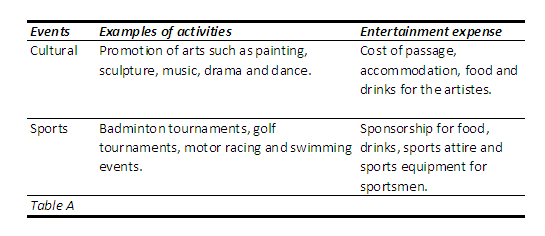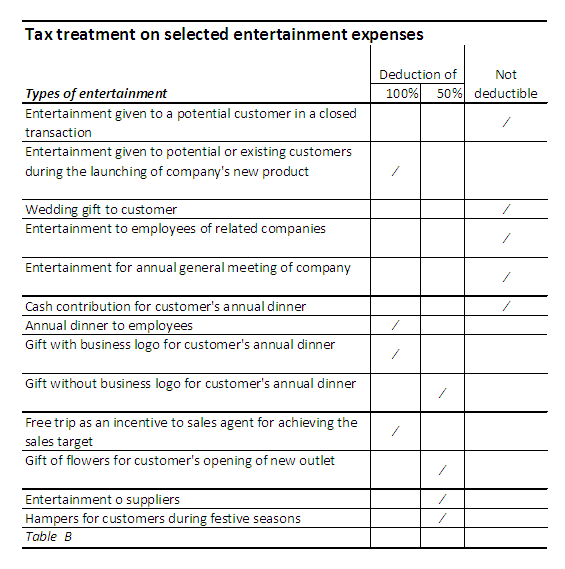A good article I have read today on how to determine tax deductibility of entertainment expenses in Malaysia on the Star newspaper
”Tuesday December 8, 2009
How to deduct entertainment tax from income tax
RSM EYE – By Lee Voon Siong
To determine deductibility of expenses incurred can be very tedious and bewildering
FOR income tax purposes, any expenses incurred in the course of a business will only be eligible for tax deduction if the expenses are solely incurred in producing the business income.
It is important to establish the deductibility of an expense as in the event of a field audit which results in the Inland Revenue Board (IRB) discovering an understatement of tax due to claims on expenses which are not tax deductible, a taxpayer will not only suffer additional tax but also a 45% penalty.
With effect from year of assessment 2004, entertainment expense will only be eligible for 50% tax deduction except for specific circumstances where it will qualify for full deduction.
This article will explain the three steps to determine the amount of entertainment expenses allowable as a deduction.
Are the expenses incurred entertainment expenses as defined in the income tax law?:
Entertainment is defined to include:
(i) the provision of food, drinks, recreation or hospitality of any kind; or
(ii) the provision of accommodation or travel in connection with or for the purpose of facilitating entertainment of the kind mentioned in (i) by a person or an employee of his in connection with a trade or business carried on by that person.
Are the entertainment expenses solely incurred in producing the business income?:
Expenses allowable for accounting purpose do not necessarily qualify for tax deduction. The entertainment expenses must be wholly and exclusively incurred in producing the business income to be eligible for tax deduction. Domestic and private expenditure charged to the business accounts will not be tax deductible. For example, entertainment expenses incurred by a sole proprietor in taking his family out for a meal will not be deductible as it is private in nature.
Are the entertainment expenses eligible for full tax deduction?
Expenses incurred on the following entertainment will qualify for full tax deduction:
1. the provision of entertainment to employees. Examples of such expenses include free meals and refreshments, annual dinners, outings and family day.
2. the provision of entertainment by a person who carries on a business of entertaining. Where a taxpayer is in the business of providing entertainment to paying customers, the cost of providing such entertainment will be deductible.
Examples of expenses which are tax deductible include provision of cultural shows by restaurants or hotels at their premises to entertain their customers and meals provided by airlines or other transportation business to its passengers.
3. the provision of promotional gifts at trade fairs or trade or industrial exhibitions held outside Malaysia for the promotion of exports from Malaysia.
Expenses incurred on gifts to customers or visitors who attend the above events will qualify for tax deduction. These would include samples of products, small souvenirs, bags, and travel tickets
4. the provision of promotional samples of products of the business of that person. It should be noted that only the products of the taxpayer given out as promotional samples will be allowed full deduction.
Examples of such expenses include:
● A complimentary drink or meal provided by a restaurant.
● Free samples of products manufactured/distributed by the business.
● Free samples of new products.
5. the provision of entertainment for cultural or sporting events open to members of the public, wholly to promote the business of that person.
Examples of cultural or sporting events and the entertainment expense related to such events are shown in Table A.

Taxpayers can do some tax planning in maximising their entertainment expenses claim by using the above provision. For instance, entertainment expenses incurred by a property developer in organising a carnival for the purpose of launching a new project or new property release will normally qualify for a 50% tax deduction. By including a cultural or sporting event, the property developer will be able to claim full tax deduction.
6. the provision of promotional gifts within Malaysia consisting of articles incorporating a conspicuous advertisement or logo of the business. The gifts need not be products of the business. However, the gifts must have a conspicuous advertisement or logo of the business.
7. the provision of entertainment which is related wholly to sales arising from the business of that person. Examples of such expenses include:
● Food and drinks for the launching of a new product.
● Redemption vouchers given for purchases made.
● Discount vouchers, shopping vouchers, concert or movies tickets, meal or gift vouchers and cash vouchers.
● Free gifts for purchases above a certain amount.
● Redemption of gifts based on a scheme of accumulated points.
● “free” maintenance/service charges or contribution to sinking fund by property developers.
● Lucky draw prizes to customers.
● Expenditure on trips given as an incentive to dealers for achieving the sales target.
● Provision of light refreshments to customers when making sales.
Entertainment expenses which are not eligible for 100% tax deduction under Step 3 above will only qualify for 50% tax deduction.
The tax treatment of some of the entertainment expenses are shown in Table B.

The process of determining the deductibility of entertainment expenses can be very tedious and often bewildering.
To ensure that the expenses are appropriately categorised, it is in the interest of taxpayers to educate their staff to provide details such as who they entertained and the purpose of the entertainment. Proper records such as invoices, receipts, payment vouchers, etc must be kept to support the claim in case of tax audit by the IRB.
● Lee Voon Siong is executive director of RKT Tax Consultants Sdn Bhd.”


